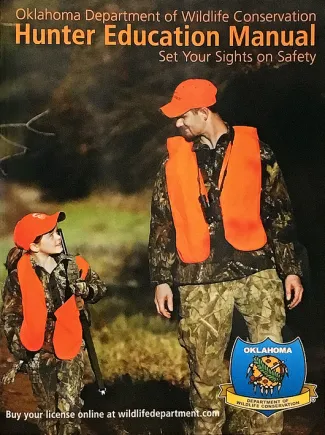As an avid hunter and outdoor enthusiast, Lance Meek, Hunter Education coordinator for the Wildlife Department, knows Oklahoma’s Hunter Education curriculum extends well beyond hunting and water safety scenarios.
“Our course does focus on safety measures for hunting situations, but we also cover topics like survival and wildlife conservation and management,” Meek said. “There are so many lessons that can apply to anyone that enjoys the outdoors.”
With the opening of several hunting seasons upon us, Meek recently shared tips and reminders from the Hunter Education course that can help everyone stay safe, regardless of their outdoor passions.

The Wildlife Department’s Hunter Education Manual, available for free at wildlifedepartment.com, extends well beyond hunting and water safety scenarios.
- Share Your Outdoor Plans. “No one expects to ever need a rescue, but this simple step can make a big difference in the off-chance your outing doesn’t go as planned.” Whether you’re going afield for a hunt, hike, or extended outdoor chore, letting someone know the general vicinity you plan to explore and your expected return time can point help in the right direction, when time may be of the essence.
- Hunter Orange Isn’t Just for Hunters. Wearing a minimum amount of daylight fluorescent orange is a safety requirement for some hunters during some hunting seasons. And while intended to alert hunters of other hunters’ presence, it doesn’t have to be a hunters-only trend. “If you’re going to spend time outdoors during fall or winter hunting seasons, regardless of the reason, let the hat you wear be hunter orange.”
- Dress for the Seasons … Not Just the Weather. Outerwear is covered in several Hunter Education lessons, and not just in the “hunter orange; dress in layers; avoid cotton clothes if you may get wet or rained on; the first symptom of hypothermia is shivering” kind of way. Meek encourages everyone to be aware of the open hunting seasons, and to dress accordingly. “That old-school Carhartt coat, a staple for many Oklahomans during fall and winter, is very similar to that of a deer. And a red, white or blue scarf or hat can resemble a wild turkey.” Many outdoor enthusiasts strive to blend in with the natural environment, but be sure to factor any open hunting seasons into your wardrobe choice.
- Firearm Safety Begins in the Home. “We talk a lot about firearm safety while hunting in the field, but those lessons, and lessons about firearm storage and safety in the home, can apply to anyone owning a firearm.” Firearms and ammunition should be stored separately in locked cabinets or safes. Never assume that a firearm is unloaded, even if it was checked only a few minutes earlier. And avoid horseplay at all times. “No matter how good your kid is, or how trained they are, firearms are fascinating to kids. Do whatever you need to do to keep kids from accessing your firearms without you being present.”
Everyone is welcome to read through the Wildlife Department’s free Hunter Education Manual, take the free online Hunter Education course (available through the NRA learning portal), or join a free in-person Hunter Education course. The manual, and its “In a Nutshell” pullouts, is a great resource for those new to the outdoor life, and serves as a great refresher for those already certified in Hunter Education. “We encourage everyone to take the course, regardless of if they ever intend to hunt, or regardless of if it’s online or in a classroom. But the free online option does allow you to pay it forward.” The Wildlife Department receives in-kind dollars by offering the free course through the NRA learning portal. Those dollars can then unlock additional federal funding that supports hunter education and other education programs.
Oklahoma’s Hunter Education program is supported by the Wildlife Department and Wildlife and Sport Fish Restoration Grant F21AF01980.